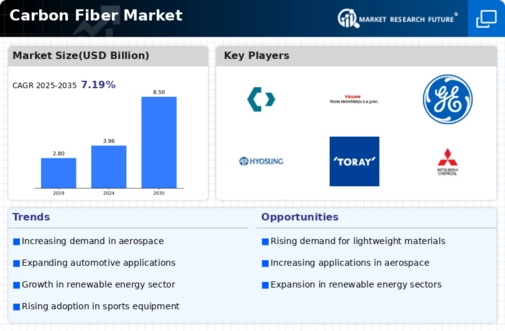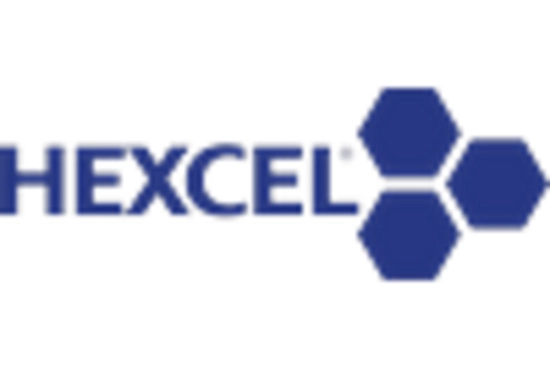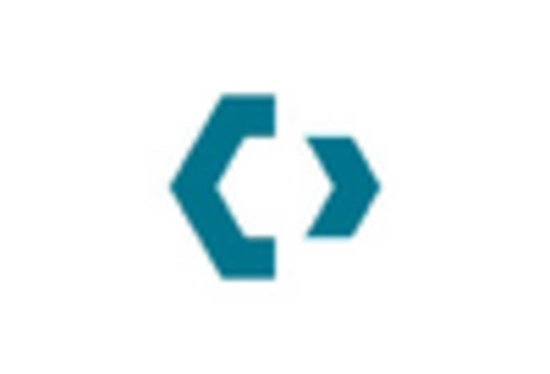Market Share
Introduction: Navigating the Competitive Landscape of Carbon Fiber Innovation
The market for carbon fibre is undergoing a revolutionary change, driven by rapid technological development, changing regulations and the demand for sustainable performance. The leading companies, including manufacturers, material suppliers and advanced manufacturers, are competing with each other to offer the best performance and highest efficiency. They use new digital tools such as machine learning and the Internet of Things to optimize their products and production processes. The producers of the basic materials are increasingly focusing on sustainable production methods, while the new entrants are disrupting established markets with new applications in the fields of aeronautics, automobiles and sports. As the regional dynamics develop, especially in North America and Asia-Pacific, strategic deployment trends are emerging towards local production and resilient supply chains. This intense competition highlights the need for strategic planners and top managers to be aware of these changing conditions and the forces driving them.
Competitive Positioning
Full-Suite Integrators
These vendors offer comprehensive solutions across the carbon fiber value chain, from raw materials to finished products.
| Vendor | Competitive Edge | Solution Focus | Regional Focus |
|---|---|---|---|
| Toray Industries | Leading in advanced composite materials | Carbon fiber production and applications | Global |
| SGL Carbon | Strong focus on sustainability and innovation | Carbon fiber and composite solutions | Europe, North America, Asia |
| Mitsubishi Chemical Holdings | Diverse chemical and material expertise | Carbon fiber and related materials | Asia, North America, Europe |
Specialized Technology Vendors
These companies focus on niche technologies and innovations within the carbon fiber sector, enhancing performance and application.
| Vendor | Competitive Edge | Solution Focus | Regional Focus |
|---|---|---|---|
| Hexcel Corporation | Expertise in aerospace and industrial applications | Advanced composites and carbon fiber | North America, Europe, Asia |
| Cytec Solvay Group | Strong R&D capabilities in composites | Specialty materials and carbon fiber | Global |
| Zoltek | Cost-effective carbon fiber solutions | Industrial carbon fiber products | North America, Europe, Asia |
Infrastructure & Equipment Providers
These vendors supply the necessary infrastructure and equipment for carbon fiber production and processing.
| Vendor | Competitive Edge | Solution Focus | Regional Focus |
|---|---|---|---|
| General Electric | Integration of advanced manufacturing technologies | Carbon fiber production equipment | Global |
| Dow | Innovative chemical solutions for composites | Resins and additives for carbon fiber | Global |
| Lanxess | Specialty chemicals for high-performance applications | Chemical solutions for carbon fiber | Europe, North America, Asia |
Raw Material Suppliers
These vendors provide the essential raw materials required for carbon fiber production.
| Vendor | Competitive Edge | Solution Focus | Regional Focus |
|---|---|---|---|
| Teijin Limited | Vertical integration in aramid and carbon fibers | Raw materials for carbon fiber | Asia, North America, Europe |
| Aksa | Strong position in acrylic fiber production | Acrylic fibers for carbon fiber | Global |
| China National Chemical Corporation | Large-scale production capabilities | Raw materials for carbon fiber | Asia |
| Formosa Plastics Corporation | Diverse portfolio in plastics and fibers | Raw materials for carbon fiber | Asia, North America |
| Hyosung | Expertise in high-performance fibers | Raw materials for carbon fiber | Asia, North America |
Emerging Players & Regional Champions
- US Hexcel: a company specialising in advanced composite materials, particularly in the aeronautics and automobile industries. Hexcel has recently been awarded a multi-year contract by a major aircraft manufacturer to supply lightweight components. By offering new solutions that reduce fuel consumption, Hexcel is challenging the industry giants, such as Toray Industries.
- SGL CARBON (Germany) - This company specializes in the manufacture of high-performance carbon fibers for industrial applications, such as wind energy and automobiles. It has recently started a collaboration with a major automobile manufacturer to supply carbon fiber components. It is a strong competitor to established suppliers because it emphasizes the importance of sustainability and recyclability.
- The Japanese company, the Mitsubishi Chemical Company, produces a wide range of carbon fiber products, which are especially suited to the sports and leisure markets. Recently, they launched a line of “green” carbon fibers that are set to disrupt the traditional market of established suppliers, by appealing to consumers’ growing concern for the environment.
- Teijin, a Japanese company, is famous for its high-strength fibers of carbon, used in a variety of products, such as aircraft and sports equipment. In response to growing demand, it has recently increased its production capacity, which may put established competitors at a disadvantage as competition heats up in the high-performance market.
- Zoltek Companies, Inc. (USA): specializes in the production of low-cost carbon fiber for industrial use. Recently signed a contract with a large manufacturer of wind-turbines, thereby establishing itself as a low-cost alternative to established producers such as Toray and Hexcel.
Regional Trends: In 2024, the carbon fiber market will have a significant regional growth, especially in North America and Europe, driven by the growing demand for aircraft, automobiles, and wind energy. The trend of specialization in technology is towards sustainable production methods and high-performance applications, with a notable increase in the use of eco-friendly carbon fibers. The new entrants in the industry are relying on the use of new technology to differentiate themselves from the market, while the established companies are relying on the quality of their products to maintain their market share.
Collaborations & M&A Movements
- Toray Industries and Hexcel Corporation announced a joint venture to develop advanced carbon fiber materials aimed at the aerospace sector, enhancing their competitive positioning in a rapidly growing market.
- SGL Carbon SE acquired a majority stake in a leading carbon fiber recycling company to strengthen its sustainability initiatives and expand its product offerings in response to increasing regulatory pressures on waste management.
- Mitsubishi Chemical Corporation partnered with BASF to innovate new carbon fiber composites for automotive applications, aiming to capture a larger share of the lightweight materials market as electric vehicle production ramps up.
Competitive Summary Table
| Capability | Leading Players | Remarks |
|---|---|---|
| Material Strength and Durability | Toray Industries, Hexcel Corporation | Toray is famous for its high-tenacity carbon fibers used in aeronautical applications, which have a high tensile strength. Hexcel has developed a new type of composite material which has high fatigue resistance, and has a high tensile strength, which has been used in the new Boeing 787 Dreamliner. |
| Sustainability Practices | SGL Carbon, Mitsubishi Chemical | SGL Carbon has implemented recycling processes for carbon fiber, reducing waste and promoting circular economy practices. Mitsubishi Chemical focuses on bio-based carbon fibers, showcasing their commitment to sustainable materials. |
| Cost Efficiency in Production | Teijin Limited, Solvay | Teijin has optimized its production processes to lower costs while maintaining quality, as seen in their automotive applications. Solvay has introduced innovative manufacturing techniques that reduce material waste and energy consumption. |
| Customization and Versatility | Zoltek, Formosa Plastics Corporation | Zoltek offers a range of carbon fiber products tailored for various industries, including wind energy and automotive. Formosa Plastics provides customizable solutions that meet specific client requirements, enhancing their market appeal. |
| Research and Development | BASF, Dow Chemical | BASF invests heavily in R&D for advanced carbon fiber composites, focusing on lightweight materials for automotive applications. Dow Chemical has developed innovative resin systems that improve the performance of carbon fiber composites. |
Conclusion: Navigating the Carbon Fiber Landscape
The carbon fibres market in 2024 is characterised by strong competition and significant fragmentation, with both the established and new players vying for market share. The regional trends point to an increase in demand in Asia-Pacific and North America. Consequently, the suppliers are adjusting their strategies accordingly. The established players are focusing on their existing supply chains and their strong brand names, while the newcomers are focusing on innovation and sustainability in order to carve out their own niches. For the suppliers wishing to gain leadership positions, the ability to integrate advanced features such as artificial intelligence, automation and flexibility will be crucial. In the changing market, the companies that combine eco-friendly practices with a focus on efficiency will be the ones to gain the upper hand.

















Leave a Comment